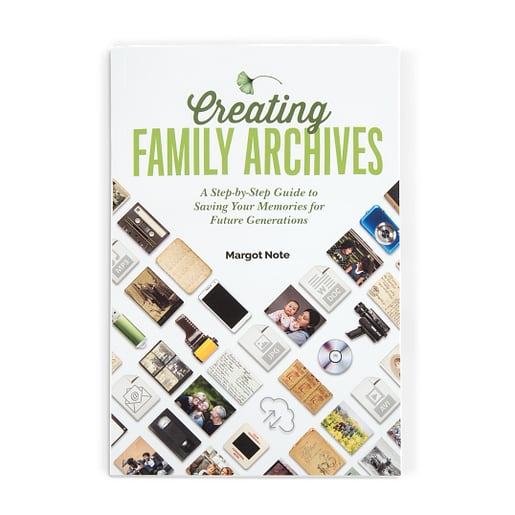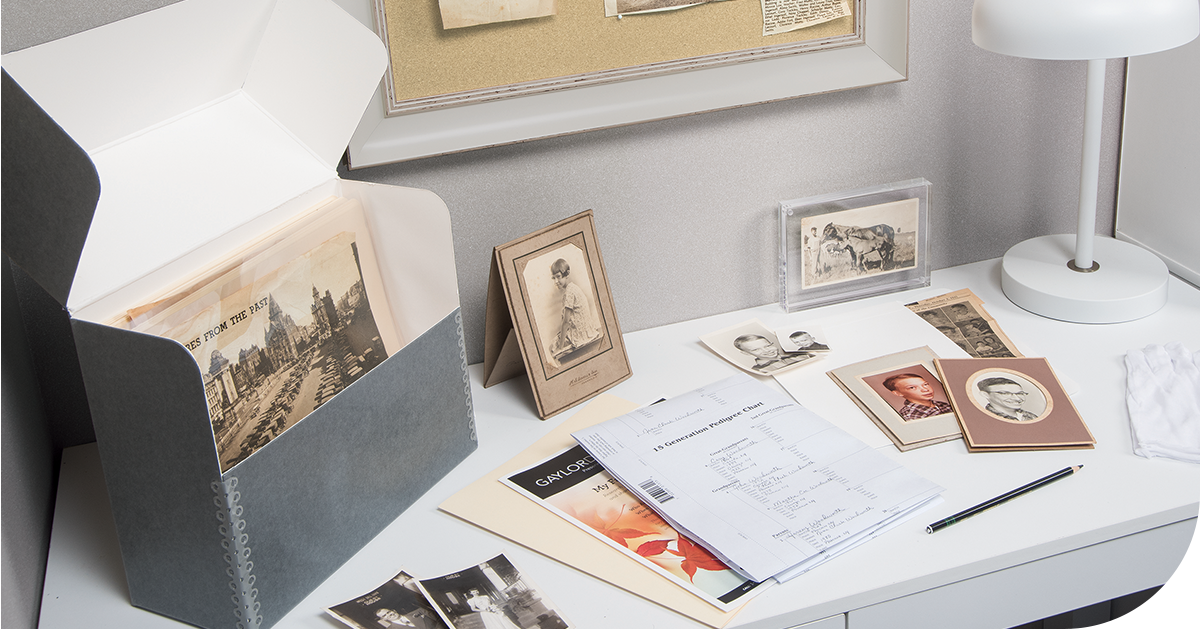By Margot Note
Author of Creating Family Archives: A Step-by-Step Guide for Saving Your Memories for Future Generations
When thinking about a personal or family history project, it’s easy to feel overwhelmed. Where do you start? What do you do? Professional archivists like myself often feel similarly! To conquer this feeling, I’ve collected guidelines about how to kick off a family history project.
Assess Your Materials as a Whole
Gather everything together. Bring out the boxes, bins, and bags filled with your memories. Find a spot where you can spread out your work, like a dining room table. You’ll want to see the breadth of what you own so you can begin to make choices.
Survey Your Collection
Look for groups with a unifying theme, such as your grandmother’s scrapbooks, letters between your parents, or photographs you took in college. Archivists evaluate materials in groups because they provide more context than individual items. A record’s value lies in being part of a larger body of materials.
Select What to Keep
Evaluate and select the materials to keep. Archivists call this activity appraisal, and it ensures that you keep only significant materials. Consider the following:
- Importance: Is this valuable to you or your family?
- Format: What type of material is this? Some items, like letters, contain more information than receipts.
- Uniqueness: Is this one of a kind? Is it irreplaceable?
- Completeness: Is this the most comprehensive content?
- Age: How old is the material?
- Quantity: How much material is there? Is it too much to keep? What’s essential?
- Quality: What condition are the materials in? Are they readable?
Determine Your Treasures
Cherished artifacts should become part of your archives. They hold sentimental, personal or historical value. Some items, such as love letters, are held close to the heart. Others, like business records, contain information about an individual’s or group’s transactions. Types of family records to preserve include:
- Audiovisual materials
- Awards and certificates
- Correspondence, letters, and emails
- Diaries and journals
- Genealogical information
- Legal documents
- Memoirs and reminiscences
- Newsletters and other publications
- Photographs
- Photo albums
- Scrapbooks
- Speeches and lectures
- Vital records
Remove Unimportant Items
Scan newsletters for family news, clip the articles and throw away the rest. Sort through bills, receipts, canceled checks, bank statements and check registers. You may wish to keep items documenting heirloom purchases or cost-of-living expenses, but the rest may be thrown away.
Look for birthdays, anniversaries and other events on calendars; once noted, throw them away unless they’re informative about your ancestors’ lives.
Toss random newspaper and magazine clippings, old paperwork, brochures and flyers. Throw away blurry, insignificant or poorly framed photographs.
Give Away What You Don’t Want
You may find items that you no longer want. Feel guiltless about letting them go; they may bring joy to someone else. You may decide to sell items or give them to relatives. You may wish to contact a local or consulting archivist to determine if your collections belong in an archival repository.
When a collection is sentimental, divide it among your relatives to share good memories. However, keep a collection intact when it’s collectible or holds historical or artistic value. This value may be reduced if you separate the objects.
Wait Awhile
If you’re unsure what to keep, revisit the materials later. Be gentle with yourself. If necessary, keep sensitive heirlooms stored until you’re ready to decide.
Concentrate Your Efforts
When you’ve finished grouping and appraising your materials, you’re left with a collection of the most significant artifacts. You’ve distinguished the records of continuing value to your family to preserve for your loved ones. You may then think about organizing them further, creating an inventory, or storing them properly.
Examine the Materials
Who created the materials? Is there a system for how they’re organized? Are there labels? Are they accurate? What type of records are they? What’s their physical condition? What are their date ranges? Are the collections complete, or are parts missing?
Consider Your Supplies
When you rehouse your items into archival-quality enclosures and containers, what folders and boxes will you need? How much? What sizes? Are special containers required? Gaylord Archival has several resources to aid you in choosing proper archival supplies.
Save What Matters
As we age, we hope that others will remember us for something we accomplished during our lifetimes. It doesn’t have to be profound, but it should be meaningful to those closest to us. If you choose to create family archives, you’ll feel the peace of mind that comes with knowing that you’ve preserved what’s important for future generations.

Ready to Learn More
About Creating Your Family Archive?
Check out Creating Family Archives: A Step-by-Step Guide for Saving Your Memories for Future Generations, written by Margot Note and published by the Society for American Archivists.

